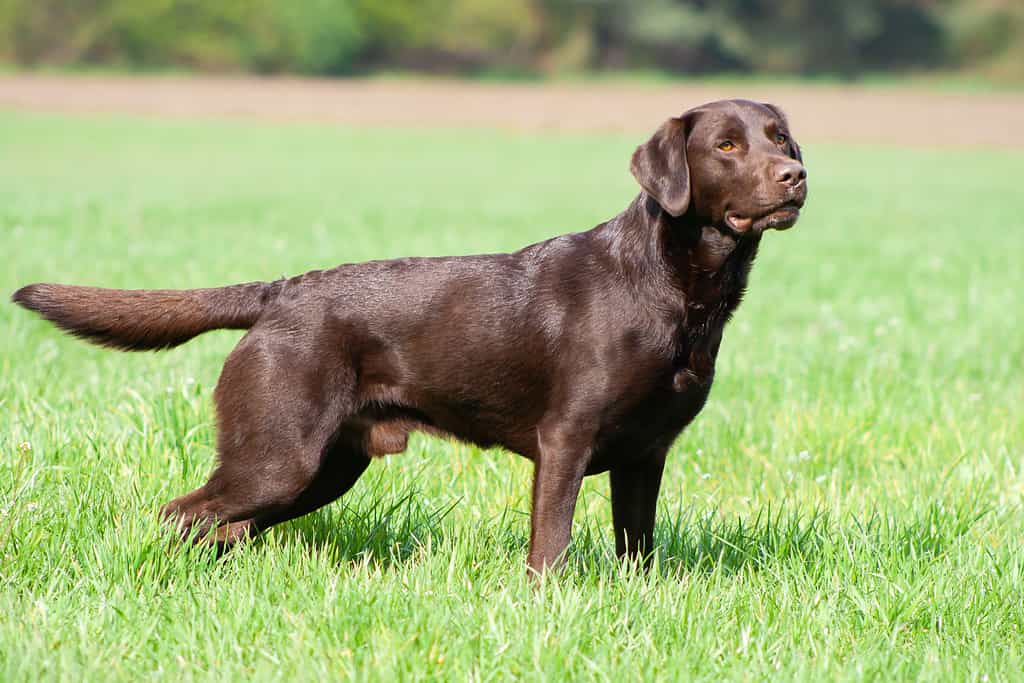Are you looking for a sweet and devoted dog? Or an active and outgoing one? Your answer will largely depend on your household makeup and lifestyle. While all dogs are unique in their own way and can be excellent companions, you may prefer to choose a breed that checks all the right boxes for your family. Discover everything there is to know about Newfoundland vs. labrador retriever, including the differences in their appearance, personalities, and overall health.
Newfoundland Vs. Labrador Retriever: A Comparison
| Comparison | Newfoundland | Labrador Retriever |
|---|---|---|
| Height | 26 to 28 inches | 21.5 to 24.5 inches |
| Weight | 100 to 150 pounds | 55 to 80 pounds |
| Coat Type | Medium wavy double coat | Short, dense double coat |
| Shedding | Moderate | Moderate to heavy |
| Drooling | Heavy | Low to moderate |
| Colors | Black, brown, gray, black and white | Black, chocolate, and yellow |
| Temperament | Sweet, patient, protective | Outgoing, friendly, energetic |
| Barking | Low | Moderate |
| Energy and Social Needs | Moderately playful with well-balanced energy and mental needs | Very playful, highly energetic, and require lots of mental stimulation |
| Training | Moderate | Easy |
| Life Expectancy | 9 to 10 years | 11 to 13 years |
The Key Differences Between a Newfoundland and a Labrador Retriever

The five main differences between the Newfoundland and the labrador retriever are their size, general appearance, personalities, energy needs, and grooming requirements. Newfoundlands are larger than labs and require more grooming. But they are not as energetic or need constant activity as labrador retrievers. Let’s break it down further.
Appearance
Newfoundland Vs. Labrador Retriever: Height and Weight
The Newfoundland is in the working group of dog breeds and is one of the largest dogs in the world. They range in height from 26 to 28 inches, with females being two inches shorter, on average. Females weigh between 100 and 120 pounds, while males reach 130 to 150. And they have stocky square frames and strong bodies.
Labrador retrievers are sporty dogs, measuring between 21.5 and 24.5 inches tall. And they weigh between 55 and 80 pounds, with females being 10 to 15 pounds lighter. This breed is considered medium-sized, and they are strong and sturdy.

Newfoundlands are one of the largest dog breeds.
©Pandas/Shutterstock.com
Newfoundland Vs. Labrador Retriever: Coat Type and Colors
Newfoundlands have a medium double coat. The outer coat is coarse and wavy, and the undercoat is dense and soft. And the coat is oily, making the dog’s fur water-resistant. Due to the Newfoundland’s double coat, they are moderate shedders. However, their grooming needs are not strenuous; they need a good coat grooming once a month or every couple of weeks. This breed is a heavy drooler, so you may be mopping up saliva all day. Newfoundlands can be black, brown, gray, or black and white.
Labrador retrievers have short, dense, double coats. Their undercoat is soft and thick, protecting them from moisture and extreme temperatures. And the outer coat is hard, dense, and waterproof. These labs are moderate to heavy shedders, and they require weekly to monthly grooming. And they are low to moderate droolers. Labrador retrievers can feature black, chocolate, or yellow colors.
Characteristics
Newfoundland Vs. Labrador Retriever: Temperament and Social Needs
The Newfoundland is a true gentle giant, featuring a sweet, patient, and protective personality. Despite their massive size, Newfoundlands are one of the best family dogs. They love cuddles and spending time with their families. And they are excellent with children of all ages and get along great with other pets. They are also open and friendly to strangers. However, they are very protective and watchful of their people. Newfoundlands will play if the opportunity arises, but they are also fine with taking it easy. These dogs are highly adaptable to your needs. And their energy and mental needs are very well-balanced. The only drawback with this breed is that they can be somewhat difficult to train.
Labrador retrievers are one of the most popular family dogs in America. They are outgoing, friendly, and energetic. They definitely live up to their reputation as family dogs. Labs are very affectionate, great with children, and get along well with other dogs and pets. They are also friendly with strangers and moderately protective. And these dogs love to play! They have very high energy needs and require lots of mental stimulation. Thankfully, they are extremely easy to train and adapt well to new situations.

Labrador retrievers are a popular family dog
©REN Photography/Shutterstock.com
Health Factors
Newfoundland Vs. Labrador Retriever: Life Expectancy and Health Problems
Labrador retrievers live slightly longer than Newfoundlands, on average. Labs have a typical life expectancy of 11 to 13 years, while Newfoundlands live an average of nine to 10 years. However, both can live longer with proper nutrition, exercise, and well visits.
There are a few health problems that Newfoundlands are prone to. They include hip dysplasia, heart disease, elbow dysplasia, dilated cardiomyopathy, bloat, hypothyroidism, and bone cancer.
Labrador retrievers can have common health issues, such as obesity, hip dysplasia, elbow dysplasia, arthritis, ear infections, bloat, heart disease, and eye problems.
The photo featured at the top of this post is ©
Ready to discover the top 10 cutest dog breeds in the entire world?
How about the fastest dogs, the largest dogs and those that are -- quite frankly -- just the kindest dogs on the planet? Each day, AZ Animals sends out lists just like this to our thousands of email subscribers. And the best part? It's FREE. Join today by entering your email below.
Thank you for reading! Have some feedback for us? Contact the AZ Animals editorial team.






